The Definitive Guide to Reopening Offices
17 May 2020
Announcements
With COVID-19 restrictions slowly starting to lift and people returning to work, we’ve put together a definitive guide to reopening offices, all the way from safety recommendations through to looking after people’s mental health.

Social isolation restrictions are starting to lift, people are starting to think about a return to work, and businesses are thinking about reopening offices. But it is a new world that we’re coming back to, with social distancing and minimising the risk of transmission governing just about everything we do at least for the next 12 to 18 months.
Whilst there’s a raft of guidance on health and safety, it’s equally important for us to not forget the human element. So we scoured the internet to put together a holistic guide of everything we could find that’s related not just to how you can safely reopen your office, but how to look after everyone who works there.
We’ve catalogued all of our research into the following categories:
- PHYSICAL WORKPLACE: Preparing the office space to minimise the risk of COVID-19 transmission
- TEAM MANAGEMENT: Managing and supporting a productive team from an organisational / managerial perspective
- MENTAL HEALTH: It’s a strange new world that people are returning to. What can we do to ensure that we look after people’s mental health, both for leaders and staff alike?
- LEADERSHIP: Perspectives and ideas for good leadership in the time of the pandemic
- FOLLOWERSHIP AND TEAMWORK: The flip side to good leadership is being a supportive team player. What can we do to support our leaders and each other?
If you would also like a PDF print out of the key items below as a checklist, please request a copy from [email protected].
Disclaimer: This guide is intended for people who manage a shared or corporate office space, as well as those who work in one. All information presented is intended to serve as a starting point and is written to be objective and FYI, rather than prescriptive.
Caveat Emptor: Any links to products, tools, or external sources presented here are purely based on our research, and not paid endorsements. In referencing this guide, please consider what is relevant to your business and industry and do additional research as it pertains to your circumstances.
Are there other resources you want to add to this? Or if you want to licence or reproduce this article, please let us know on [email protected].
1. PHYSICAL WORKPLACE
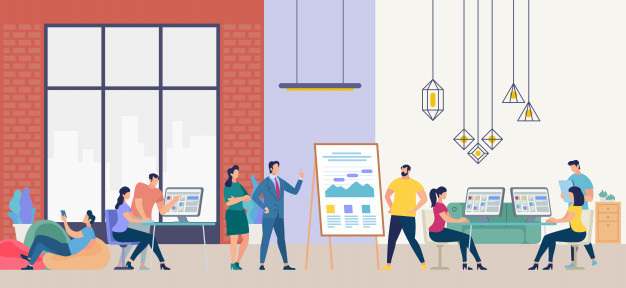
We’re going to start with the physical workplace, as this is the most pressing aspect of preparing the office for reopening. The guiding principle is simply mitigating the risk of spreading the novel coronavirus. In looking through all the advice from the internet, there’s several major categories to consider.
Personal Protective Equipment (PPE) consumables and equipment
Firstly, do you strictly need to provide everyone who enters the workplace with PPE? Well, in reviewing all of the guidelines we found… not necessarily. In short, if preventative measures such as physical distancing, frequent hand washing and cleaning of high touch surfaces are effectively undertaken, the use of any additional personal protective equipment (such as face masks or single use gloves) by staff may not be required.
That said, having both good preventative measures and PPE can further reduce the risk, so perhaps a better question to ask is: “What’s a reason not to provide additional PPE in your office?” For official guidelines, check out Safe Work Australia.
This is essentially a shopping list of items that may not have been necessary in the old world, but is now worth having on hand to minimise risk of transmission. Here’s a potential shopping list, along with links to local Australian businesses and social enterprises (where we could find them. Again, please do your own research):
- Face masks
- Hand sanitisers
- Alcohol or anti-bacterial wipes
- Gloves
- Extra disinfectant spray and paper towels
- Hands-free door openers such as these, or alternatively metal grips installed on to the bottom of doors that let people use their feet to open doors. SafeOpen and StepNpull are both local Australian businesses that sell the latter
- Motion sensor bins
- Motion sensor hand sanitisers
- Portable temperature checks that you can pick up from Chemist Warehouse or Seton
- Air purifiers, though according to this Choice article, their impact in reducing airborne transmission might be minimal
Office layout
Does everyone need to be 1.5 metres apart? How many people are allowed to be inside a room? What if people can’t maintain 1.5 metres in an office? Here’s the key guidelines from Safe Work Australia to maintain physical distancing, but in summary:
- The ‘maximum recommended occupancy’ of people in a room is calculated by ensuring each person has on average 4 square metres of space. Calculate this by multiplying the width and length of a room (in metres), and then dividing by 4
- Within each space, try to configure the layout such that each person has at least 1.5 metres apart. Safe Work suggests using furniture, plants, or floor markings (with tape) to denote distances

However, it’s important to remember that these are recommended guidelines. Safe Work acknowledges that there are workplaces where this isn’t physically possible, and thus there is a broad recommendation to simply review how your practices and procedures, and adjust where relevant. For more specific guidelines for your business, Safe Work has quite a comprehensive and interactive tool.
To make life a bit easier, here are some other approaches that we found being undertaken by organisations around the world, both in terms of office equipment as well as layout:
- Portable partitions and partition extenders to minimise risk of airborne contamination
- The introduction of antimicrobial surfaces for common areas
- Ensuring that meetings and group gatherings are in places that are well ventilated (or conversely, locking down rooms that are poorly ventilated), and implementing a buffer policy before and after each meeting
- Leaving doors open to minimise shared touching (or given everyone door openers)
- Staggered seating arrangements
- For larger offices, introducing one directional traffic flow to minimise ‘clustering’ effects between people
- Elimination of hot desking to minimise cross contamination
SIDEBAR: CAN’T FIND THE RIGHT EQUIPMENT FOR YOUR OFFICE?
Every workplace will be configured a little differently, which means it might be difficult to find the right piece of commercially available equipment for your office. Why bold those two words? Because if there’s a time to take advantage of the rise of custom fabrications, 3D printing, and small scale production, it is now.
Take Fab9 in Melbourne, Australia (see photo below). This is a space in which just about any type of equipment can be created at low volumes. Does your office need a partition that’s exactly 1.2m high and can be clamped on to a desk at a right angle? No problems. Or see through perspex guards for the reception desk, but the desk is an odd shape? Get it fabricated.
There are MakerSpaces like this around the world, and many of them have transitioned into creating PPE to support their local communities, from face masks to other protective furnishings.
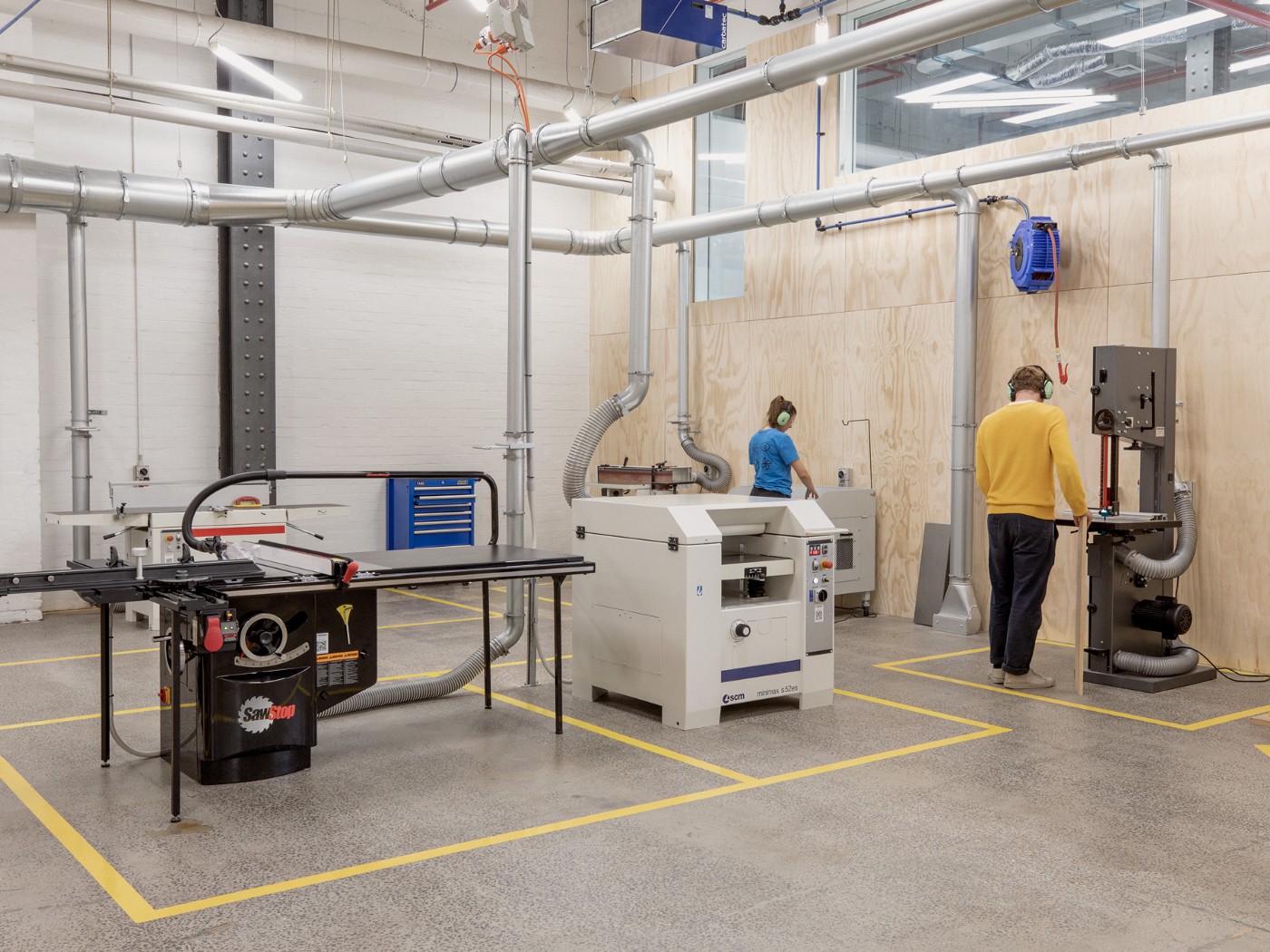
Daily operational policies and protocols related to safety
Firstly, here’s the general resource pack from the Department of Health, which covers some of the basic information you may want to print and have on display. Safe Work Australia also has a printable checklist that’s worth reviewing. Beyond that, there’s a few other policies and protocols for your consideration:
- Symptoms – Prominently display a reminder list of symptoms, as well as what to do if someone has self-identified a symptom. This might start with notifying a designated representative in the team, all the way through to where to book in a test
- Clean desk policies – Introducing genuinely clean desk policies, which include wipe downs at the end of the day
- Busy / communal areas – Consider what policies are most appropriate for the busiest areas in the office, such as the kitchen or reception area. Follow the Safe Work Australia guidelines from earlier
- Food and snacks – Remove (with great sadness) shared snack bowls or other shared food bowls where multiple people may be dipping their hands into the same container
- Elevators and lifts – For those in large office blocks that utilise elevators, consider what is an appropriate limit for the number of people per lift
- Enclosed areas – Similarly, consider protocols for any other enclosed areas such as wipe downs for phone booths or pods
SIDEBAR: ARE AIR DRYERS SAFE?
Are air dryers safe? A few years back, there was a viral post showing how hand dryers and, in particular, Dyson Airblades may be spreading more germs around the bathroom. But do they really? This is what our research found:
- This 2000 study comparing different drying techniques suggest that there was no statistical difference.
- This 2008 study showed jet air dryers (specifically the ones where you stick your hands into a slot) collected about 80% more bacteria inside walls of the air dryer than on the bottom of a toilet seat, especially in public bathrooms.
- This 2014 study showing that jet air dryers appeared to spread 25 times more germs than paper towels.
- This 2016 study suggests that the use of any form of hot air dryer will disperse more germs around the bathroom, compared to paper towels.
- This 2019 study suggests that jet air dryers were more effective at clearing bacteria off your skin.
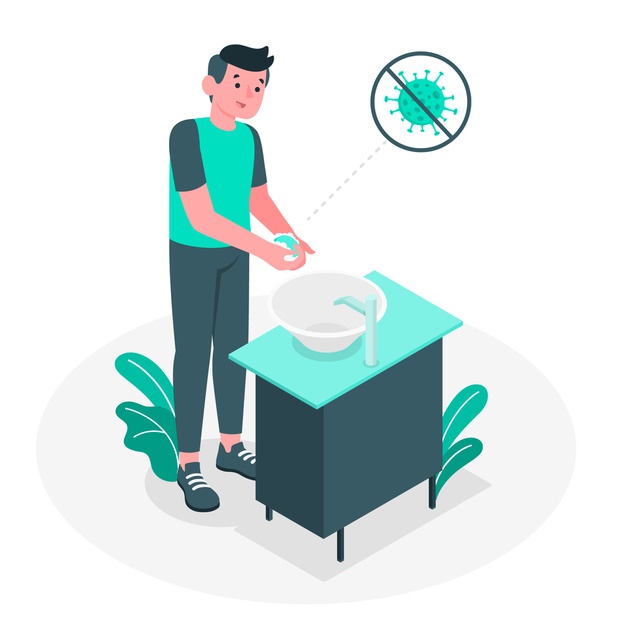
However it should also be stated that the 2008, 2014, and 2016 studies were funded or supported in part by the European Tissue Symposium, whilst the 2019 study was funded by Dyson, so be extra wary of conflict of interest.
This 2020 article by Wired does a good job of breaking down some more of the nuances and conflicts, but we thought we’d end on this quote from Mark Wilcox, Professor of Medical Microbiology at the University of Leeds who supervised yet another international study in 2018: “The problem starts because some people do not wash their hands properly.”
Strategic risk mitigation
The pandemic and lock down may have caught many people off guard, but we can learn from our experience to minimise disruptions in the future. As such, there are some big questions in the realm of risk mitigation that are worth considering proactively. We can’ provide any definitive answers as each business will be different, but consider these possibilities:
- What do you do if there is an outbreak in your office?
- What is your policy on privacy, especially if someone falls sick? Do you tell others in your organisation or keep it private?
- What do you do if a team member (or their close relations) dies from COVID-19?
- What do you do if your leadership team or people critical to the operation of your organisation become sick?
- What is your strategy for information and cyber security if people continue to work remotely?
- If you’re not cloud-based with your data, what is your strategy if you can’t access your server and comms room?
- What is your strategy if the entire country goes back into lockdown?

Here are some other resources we found that may be of value
- How South Korea reopened for business
- How Taiwan reopened for business
- A Time article on other Asian countries and how they’re reopening
- This Guardian article that examines how different countries around the world are exiting from COVID-19
- The Department of Health’s model of the current impact of COVID-19 in Australia (dated 1 May 2020)
- Work Safe Victoria’s guide on preparing for a pandemic
If you’re looking for business-recovery strategies, please see our section on Leadership below.
For larger organisations
We also found a few other considerations that are more relevant for larger firms during the pandemic:
- Consider if there are specific roles to hire for or to assign to a responsible team member:
- Thermal Scanner role for high thoroughfare entrance areas, whose job is to take the temperature of all visitors
- Elevator Attendant
- Pandemic Disease Manager, whose primary responsibility is to look after all pandemic-related issues for the organisation
- Move towards touchless offices by installing motion sensors for everything that is considered high touch, especially doors
- Budget allowing, consider structural changes such as more sophisticated air filtration and Heating, Ventilation, and Air Conditioning (HVAC) systems to purge the air on a nightly basis (here’s an explainer)
However we would be remiss to not defer to the International WELL Building Institute, who have released a holistic set of strategies that cover everything from improving air quality, to maintaining water quality, through to championing community resilience and recovery. For any large organisations looking to re-design or re-configure their workplaces for the future, the WELL guide is a great starting point.
Useful links from industry bodies
- Australian Government Department of Health
- Safe Work Australia
- All public advice on COVID-19 from the World Health Organisation
- Work Health and Safety guidelines for business owners from business.gov.au
2. TEAM MANAGEMENT
It’s been said that of all things that could have brought about a digital revolution, the pandemic is the actual catalyst that has drastically accelerated it. With social distancing forcing us to change the way teams work, how do we continue to manage people from an operational sense? What are some techniques, methodologies, and tools that can enable businesses and teams to continue to work effectively and productively?
This section covers the logistical return of people to offices, suggestions to improve work from home productivity, productivity and project management tools, and finally how to enable ‘creative collisions’, one of the biggest losers from social distancing.

Physical people management
Let’s start with the most tangible aspect, which is managing bums on seats, whether that’s in the office or at home. There are several approaches being considered around the world:
- Definitions of remote working: First things first, if your organisation is doing any sort of remote working, it could be useful to be specific about what type of remote work arrangement you’re pursuing
- Split teams - in which two or more teams are working in completely different geographic locations
- Hybrid teams - in which you have one fixed location, but with some staff working remotely
- Fully remote - in which there is no fixed office at all
- Split teams - in which two or more teams are working in completely different geographic locations
- Phased returns: Are you planning on a phased return of people to offices? If so, which teams return first? There’s a couple of approaches to consider:
- Based on the greatest needs of the business, such as supporting client delivery
- Based on the teams that require face to face collaboration to function
- Based on giving people who need a break from their home offices as a place to work. This is more about mental health than about productivity, however it’s important enough not to be dismissed
- All of the above are valid points. Ultimately however, to err on the side of caution, the basic principle of social distancing still applies: “Do people need to be physically together for this?”
- Here are the suggestions from the Department of Health
- Remote working etiquette: Not everyone shares the same habits at home as they do in a workplace. Whilst it’s common to have workplace etiquette printed up on posters in the office, do you have one for remote working? Here some tips as a starting point
- Roster / timesheet management: If you are implementing a roster, how are you managing and communicating that roster? There are some online roster management platforms that you can try such as Deputy or WorkSchedule.Net, though for smaller teams, a shared Google Sheet document could be sufficient
- Flexible work policies: If you’re not going down the path of rosters, what are your policies for flexible work? And in particular, how will you facilitate communications within the team so that not everyone decides to flexibly work from home or work in the office at the same time? Here’s an article from PWC that also dips into the financial aspect of flexible work policies
- Sick leave / carer’s leave policies: Similarly, what are you policies for sick leave or carer’s leave? Can they remain the same or do they need to change for COVID-19? What if people need to take time off to get themselves or a carer tested? Please make sure to review the Fair Work Ombudsman’s website for a comprehensive breakdown of employer obligations
- Videoconferencing: A 2017 study found that 43% of workers have difficulties understanding people over videoconferencing, and 31% have experienced bad connections and dropped calls. Whilst Zoom and Google Hangouts now feature heavily in the COVID-19 world, it’s worth considering the efficacy of the platform. For example, when Atlassian acquired Trello in 2017,the team learned that you shouldn’t have seven employees sitting around for a meeting if even one person is dialing in remotely. It creates an imbalance in ‘democratic interaction’, which means that the person dialing in is at a disadvantage compared to those in the room. If one person is forced to dial in, it may be significantly more equitable for all participants to also dial in
- Vehicular travel: It’s forecasted that there will be a surge in car travel as people avoid public transport. This has quite a few implications for team managers:
- People may need more time to get to and from work, as everyone starts to fight for parking
- What can you do to make it easier for your team? Are there company cars that can be shared between staff? Or parking spaces that can be shared between those rostered to work in the office?
- Some large organisations whose people need to transit between different sites have looked into chartering their own shuttle service
Working from home

If a great deal of your workforce will be working from home for the foreseeable future, it could be a valuable investment to ensure that your team is equipped with the right tools to enable them to work as efficiently as possible, beyond having decent laptops.
- Home Internet – The speed and reliability of the internet is vital for productivity, but it is worth remembering that not everyone adopts the same approach at home. As such, whilst most people may have wifi at home, some may be working off their mobile connection whereas others have the fastest possible connection. Consider subsidising your staff for their home internet to ensure everyone has a reliable connection to work from
- Audio and visual – Just about everyone who has experienced some form of video conferencing will have experienced the noisy interruptions of background noise, or poor microphones. Consider investing in a headset and microphone combo for your staff, to ensure clear communication. Similarly, a consistent quality of webcams may also improve video conferencing
- Office equipment – Many people’s homes may not be configured for work at all, and may lack the ergonomic comforts of offices. Standing desks, ergonomic chairs, and ergonomic keyboards and mice may all be worthwhile investments to help your staff work safely and effectively
- Satellite offices – For those who absolutely need a way out of the home office, consider the use of satellite offices in coworking or serviced offices to be shared among teams. For example, many coworking spaces have private rooms that are appropriate from a social distancing perspective, but which could also be shared among team members.
Work From Anywhere (WFA) is an evolution, in some ways, of WFH and completely separates the ‘place’ of work from productive outcomes. The Harvard Business Review did some research on this that’s yielded some fascinating insights:
- People who transitioned to WFA relocated, on average, to locations with significantly lower costs of living, representing an effective increase in real salary for employees
- Managers of WFA employees should mandate use of a common set of technology tools, which results in a 3% increase in productivity
- Employers should leverage any geographic clusters of WFA employees that emerge, especially among employees doing similar types of work. Providing funding for periodic informal meet-ups is a small investment for a potentially significant amount of employee learning (see Creative Collisions section below)
- It seems best to keep newly hired employees co-located in the office with experienced peers long enough to benefit from the informal learning that happens organically in a face-to-face environment
- And finally, you need to consider the type of work itself, as not all work lends itself to WFA
SIDEBAR: ARE WE MORE PRODUCTIVE AT HOME?
Are people really more productive when it comes to working from home? With companies like Twitter and Square announcing that people can permanently work from home if they want to, we thought it might be prudent to look into this a bit more.
Firstly, Citrix commissioned a survey of over 2,000 people to gain some insights. They found:
- 36% said not having to commute resulted in less stress during the work day
- 38% said they were working longer hours (19% said less)
- 70% believed their productivity at home was the same or higher
No brainer, right? Well… contrast it with this survey of 1,000 working age employees who have made the transition from office to home, which found:
- 52% of workers feel more anxious working from home
- 35% don’t feel clear what their expectations are
- Women were 9% more likely than men (55% vs. 46%) to say they felt more anxious working from home
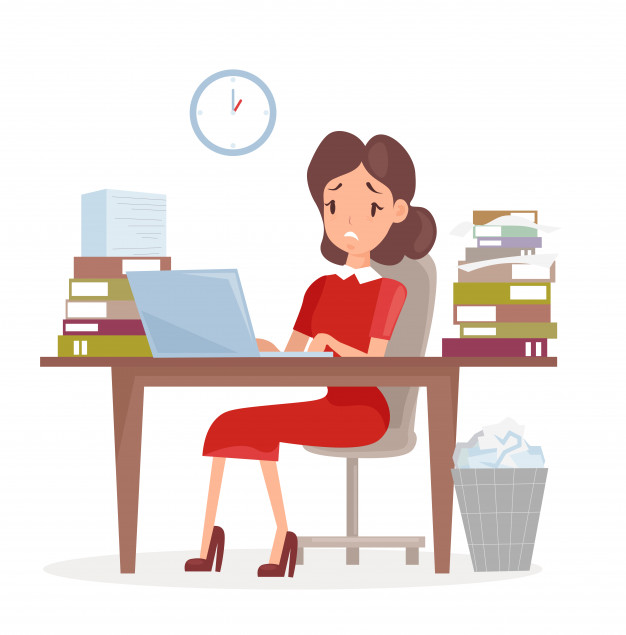
So what’s going on? If we dig into the some of the qualitative comments, we can start to glean some deeper insights:
- “I am expected to do my job from home, which I have never done. I am in charge of my 1-year-old alone all day. I’m unsure of how to do my job effectively online.”
- “[I’m] Worried my work won’t be good enough. Worried about the strain my work puts on my family when we are home together. Worried that I am not as available to my child as I should be.”
What appears to be happening is that when productivity is measured strictly through a ‘To-Do’ task on a manager’s screen, it can undervalue the effort that was put into getting the task checked off. For example, for parents with young children, the ‘To-Do’ task may not convey the challenge of balancing a crying child and developing a report, or a task that was done in the middle of the night as that was the only time free from distraction. This type of effort (aka Presence Disparity) is almost completely invisible to managers (especially those who are predisposed to micromanaging), but is a crucial component of managing a team’s mental health. For more, check out our mental health section below.
This MIT Sloan Management Review article also shares several nuanced suggestions on the importance of time management and time signals. Here are some key examples:
- Pay attention to output, not time - Judge what people do and the quality of their output, not how quickly they respond to an email or how often they are on Slack
- Explicitly discuss time - Make a regular practice of doing informal one-on-one check-ins with employees to get a sense of their individual time needs, burdens, and pressures, and be empathetic about their personal situations
- Support your employees’ boundaries and signal your own - This can help with introducing structure to work, and delineating between work and home
- Refrain, when possible, from sending communications outside of standard work hours - People may feel a need to respond to work emails outside of work hours, which crosses those work / home boundaries. If an email is sent out of hours, make it clear whether an urgent response is actually needed. Alternatively, schedule the email to be delivered the next day
Productivity and project management
So with the logistics of people sorted, now on to the challenge of actually managing work across remote teams.
- Project management methodologies for remote teams – Have you always wondered about what the fuss is with Agile? Or do you need something different? Here are some basic resources to point you in various directions:
- First, we recommend checking out this MIT Sloan Management Review article, which looks at the principles of Dynamic Work Design and how you can apply it to your organisation. Importantly, it serves as a useful lens through which you can look at project methodologies such as Agile and Waterfall
- Agile project management overview
- Waterfall methodology, which is a linear form of project management typically for software development
- And in-between Agile and Waterfall is the Spiral model
- Less methodology and more project management considerations for remote teams, check out this article by Hubstaff
- Project management and task allocation tools – There are a variety of tools available that by and large try to replicate the same thing, that being the assignment of tasks between teams and individuals. We’re not going to list all of them (though can check a big comparative review here). Each have their pros and cons, thus it’s always worth trying them out for free, with a small group of people to test out its efficacy and fit for your organisation:
- Asana
- Trello
- Monday
- Basecamp
- SmartSheet - Where the first 4 links are task management, SmartSheet is more like Microsoft Project, gantt charts and all
- Communication tools – As with project management tools, there’s a variety of different tools available (many free) for use.
- Slack – The ubiquitous corporate chatroom platform used by corporates and tech businesses everywhere
- Discord – A younger (almost millennial) version of Slack but with quite robust video and screen share integration
- Microsoft Teams – Microsoft’s version of Slack
- Collaboration tools – There’s nothing quite like working as a team on the same document. Whilst DropBox, Teams, and Google Drive all offer the basics of shared document editing, there are several other tools that take collaboration to a new level via shared whiteboards and graphical interfaces:
- Miro – An enormous virtual whiteboard that comes pre-built with numerous templates, from project plans to value proposition canvases to customer journey maps
- Mural – Like Miro, but for Mac and iOS users
- Milanote - For the creative teams, check out Milanote. Like Miro and Mural, they’re visual whiteboard but are geared much more towards creative projects. And they’re Australia-based to boot.
- Notion – An all-in-one integrated workplace that incorporates notes, tasks, project management, and more
Above all, there’s one important rule to remember when it comes to methodologies and tools: “It’s not the methodology or the tool that matters, it’s the shared discipline of using them.” In other words, whichever approach, platform, tool, or methodology you use, make sure to spend extra time to ensure that everyone uses it in the same way. This Harvard Business Review article does an excellent job of conveying some of the challenges that can occur if a business only focuses on technology, without giving sufficient thought to process and communication.
‘Creative collisions’
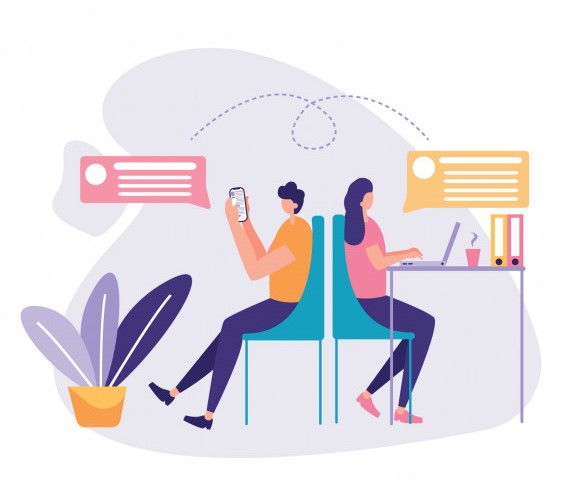
No doubt most teams will already have in place regular check-ups and virtual team meetings, however one of the biggest losers from social distancing is the concept of ‘creative collisions’. These describe spontaneous, unplanned situations where people come together to come up with new ideas or create innovative solutions, a la ‘water cooler conversations’.
However, they also describe situations where people build meaningful connections with each other, whether it’s finding out about a shared hobby, or a personal check-in on an issue that one particular individual may not feel comfortable sharing on a group chat.
So how do you enable creative collisions in the world of social distancing?
- Coffee roulettes – Encourage one on one / small groups of team members to meet with the express purpose of letting them chat, or simply get to know each other. You can use this platform, or get a tech whiz in the team to create on in Excel
- Creative play time – Consider dedicating blocks of unstructured time for people to simply be creative or innovative. This can be both virtual or in person (depending on social distancing restrictions), but the purpose is simply to let people have a space in which they can simply play, be creative, and experiment. Alternatively, contact ColourSpace and we can help you coordinate artist lead creativity workshops both virtually and in person.
- Virtual brown bag lunch - Here’s how Deloitte runs their virtual session, including important but unexpected suggestions such as ensuring there is ‘no structure’, to enable the free flow of ideas without a formal agenda.
This article by Fast Company shares some nuanced insights on how some of the big tech companies who embraced remote working prior to the pandemic have approached office designs. Atlassian, Basecamp, and Github consider the office purely as a meeting place, and thus have configured their spaces to specifically cater for that. In particular though, one insight stood out: “When you have employees who are local, who come into an office every day, their opinion of your office is the aggregate sum of many days—good, bad, and indifferent,” says Lara Owen, the director of workplace operations at GitHub. “With remote employees, we only have one or two days to get it right.”
This insight is fascinating as it implies that businesses should invest more on making your offices warm, engaging, and interactive, in order to make a good impression for staff. Or where in doubt, ask your staff what they would like to see in the office.
3. MENTAL HEALTH
Maintaining positive mental health will be one of the most important aspects for organisations to stay on top of in the post-COVID-19 world; it’s certainly something that we here at ColourSpace are especially mindful of given it’s part of our raison d’être.
But rather than just listing various external services to outsource to, let’s start from a position of empathy. Let’s first think about what it’s like from a team member’s perspective, who is just returning from work. Then – because bosses are also human beings – let’s consider what it might be like for a leader or manager.

Mental health challenges for team members
“What’s probably going to be running through people’s minds is: ‘Everything else has been disrupted, I just wanted the office to be like it was.’ Give people time to mourn the past, because you may not care about it, but they do.” – Ken Matos, Director of People Science at CultureAmp.
Whilst this may not apply to everyone, it can be useful to consider the different headspaces people can find themselves in:
- People may be used to working in a homely environment – For many, the home environment has become a place of work. Returning to a corporate workplace could be jarring, especially if the workplace now has stringent safety checks.
- People may be fearful – Especially of coming out of isolation and into communal spaces. In particular, people may become hyper aware of personal space and may be more standoffish with colleagues, which can have a negative impact on culture.
- People’s lives may have blurred together – Those working from home may have found their work and personal lives blurring together, and it may be difficult to separate the two, with a net result of people being less productive or efficient. On the flip side, some may be looking forward to returning to the office to create some form of delineation in their lives.
- People may want to be distracted - Not everyone may want emotional support; some may simply need something to do to take their minds off the past few weeks.
- Self-isolation may have increased depression or anxiety – For some, being in isolation may have contributed to various levels of social anxiety or depression, meaning people may be in a more fragile state of mind.
- People may still be looking after dependents – Whilst people can return to the office, other parts of their lives may not have returned to normal. For example, schools that have not re-opened, or elderly family members in their care.
- People may have lost their jobs - Or have loved ones who have lost their jobs, and may be under significant financial pressure.
- COVID-19 may have highly personal implications for some people – This ranges from people whose relationships have suffered during the isolation, through to victims of domestic violence, and all the way up to those who have lost loved ones.
Mental health interventions for team members
Recognising the myriad of situations that could be affecting a team, the following is a list of interventions for organisations to take into consideration in terms of supporting the mental health of team members. Many of these interventions ultimately fall under the umbrella of ‘Wellness Programs’, however it’s important to first consider which challenges are faced by your team. Just as it is important to have these programs on hand, it’s equally important to understand when not to offer emotional support. There is no one size fits all solution for mental health, and when in doubt, remember to talk to people first:
- Create warm environments – To soften the workplace and create a warm and engaging environment, don’t underestimate the power of art. ColourSpace is an affordable way of creating a more homely, engaging workplace by filling it with local art. Furthermore, our service takes advantage of wall space and will not impact social distancing limitations.
- Staff re-orientation programs – Consider staff re-orientation programs to help people reset their expectations for returning to work, which doubles as a useful way of establishing your office’s social distancing and safety procedures.
- Counselling programs – Where feasible, offer in-house counselling programs or engage professionals to provide counselling programs for staff. Check out the Employee Assistance Program Association of Australia (EAPAA) for further guidance on EAPs
- Conflict resolution – A return to work can create new types of conflict in the workplace, with people re-establishing social boundaries. A conflict resolution strategy designed for a post-pandemic environment could prevent conflicts from escalating. Here’s an article from the Harvard Law School on online dispute resolution, and a more workplace-centric guide for improving communication and minimising conflict
- Diversional mental health support programs (aka Wellness and Team Building) – Not all mental health interventions need to be formal. Creating opportunities for teams to come together can help reconnect them, as well as reinforce the culture of your organisation. ColourSpace again offers several creative workshops designed specifically for this.

Mental health challenges for leaders
Let’s also look at mental health from a leader’s perspective, because they’re also human beings. In addition to all the potential factors that could impact a team member above, these are additional challenges a leader may face:
- Being responsible for having the answers – Just as the nation looks to a leader to have answers throughout the pandemic, team members will also be looking to their leaders to have the solutions to workplace challenges, creating extra pressure and burdens on leaders.
- Team members who have died, or whose loved ones have died – There’s a myriad of complex issues that leaders have needed to manage in the case of deaths, whether that’s supporting the rest of the team, or supporting team members who have experienced deaths in the family.
- Team members have been let go – Many businesses have had to make tough decisions to ensure business survival, with leaders having to lay off staff. Not only can this weigh heavily on a leader, they also must manage the tension and nervousness that may now exist for the rest of the team.
- The pressures of running a business – For CEOs, founders, and business owners, they may face the pressure of keeping the business afloat. For some, this could mean an entire lifetime of work that has disappeared. In addition to managing people, they may also be faced with a battle for survival.
- Loneliness of leadership – Finally, whilst leaders can be a support system for staff, some leaders may lack their own support structure. It can be lonely to be in a position of leadership, as they must frequently present an atmosphere of strength, optimism, and confidence, whilst having no one to fall back on.
Mental health interventions for leaders
Again, beyond the list of interventions for team members that equally apply for leaders, there are a few additional interventions to consider for leaders:
- Peer support groups – Peer support groups (aka Masterminds) are regularly scheduled catch ups between peers, the aim of which is to provide a safe space to talk openly about issues from mental health and challenges. Participants do not need to be within the same organisations; it may be beneficial for leaders to join peer support groups that are external to the organisation in order to gain fresh perspectives.
- Further delegation of responsibilities – Consider if there are additional burdens introduced by the pandemic on the leader, that could be delegated to other team members. Not only does this reduce the pressure for leaders, it could give team members an opportunity to improve their own leadership skills.
- Board support - Ensuring that the leadership team’s mental health is a standing item on board agendas
- Mental health awareness programs – Programs specifically designed to support the open discussion of mental health in the workplace, in which both leaders and team members can participate, demonstrating that mental health issues can impact all levels of an organisation.
External mental health initiatives and interventions
Finally, there are various mental health schemes, organisations, and support services available to the general public.
- Heads Up, an organisation that focuses on mental health in the workplace
- Beyond Blue has a dedicated page for the coronavirus
- Lifeline - If you are thinking about suicide or experiencing a personal crisis call 13 11 14
4. LEADERSHIP
There will be a great onus on leaders to lead effectively during the pandemic. There are far more established authorities on leadership than us, but at the very least what we can do curate a variety of these perspectives as a springboard for you to consider.
We’ve categorised them by management (i.e. anything business related) and leadership traits (i.e. mindsets).

Management
We hit up each of the big consulting firms and some leading industry bodies to check out their take on business recovery:
Bain and Co takes a ‘supply and demand’ type approach to strategic recovery, and have captured it in an ‘Advance, Retreat, Adapt, Repeat’ model to govern the recovery process. This quote in particular stood out:
For most executives, the task at hand will be less like restarting a business than like starting a business. They face some of the same questions that confront every business founder: What are the customer needs that I can serve? Where is the demand and how will we configure the business systems - supply chains, production and service operations, distribution - to meet it?

McKinsey takes a more holistic look at the broader environment that business will be operating in, from the influence of government, health, economy, and socio-cultural impacts. It’s perhaps aimed slightly more at government than at businesses, but it is still useful nonetheless to understand the operating environment that different businesses may find themselves in.
Accenture similarly takes a holistic approach to business recovery, but where McKinsey took more of a PESTLE analysis approach, Accenture within the organisation itself. Their in-depth article starts with Business Strategy, then works through the Workforce, Customers, Operations, Finance, and Technology, with each sub-section linked to an in-depth analysis.
The Australian Institute of Company Directors (AICD)released an article on the role of Boards in overseeing recovery strategies, focusing on the need to transition from ‘crisis response’ to now taking a step back and: “…turn their minds towards recovery and not lose sight of their overarching role and responsibility for effective organisational governance, strategic direction and planning.”
Their article goes in-depth into updating strategic plans, business continuity, finance and capital structure, stakeholder relations, technology and cybersecurity, and recovery.
EY has identified five priorities for business leaders to consider, with many of these identified in from perspectives and experiences from China and other Asian countries where COVID-19 first impacted. Specifically:
- Prioritise people safety and continuous engagement
- Reshape strategy for business continuity
- Communicate with relevant stakeholders
- Build resilience in preparation for the new normal
- And finally, maximize the use of government support policies
The first four items are captured in this diagram below.

KPMG recommends focusing on strengthening long-term competitiveness in order to prepare and adapt for a post-COVID-19 world. Here’s their paper, but in summary:
- Work across multiple time horizons in strategic planning and risk management.
- Put emphasis on long-term competitiveness of the company in investor engagements.
- Integrate interests of key stakeholders in key decision-making processes.
- Align all COVID-19 responses with the corporate purpose and values.
- Assess the ability to enhance the resilience of the company.
SAI Global has developed a free Pandemic Plan template to protect employees’ health and safety, as well as keep business operations running. The template is based on guidelines from the WHO and CDC, and is designed to help organisations designate a pandemic planning team, undertake risk assessments, determine business impacts, and set responses. Whilst we’re past the initial wave of the pandemic as at time of writing, a Pandemic Plan could still be useful to have on hand.
CBRE takes a helicopter view of remote working, and highlights opportunities for an organisational approach to the remote working arrangements of the future. In particular, in the second half of their article, they see bigger opportunities on structural reforms to how teams work, from minimising unnecessary meetings to re-defining what an ‘empowered employee’ is.
Flying Solo - a leading resource for solo founders and business owners - share a terrific deep dive into how businesses can develop a COVID-19 recovery plan, breaking things down to 4 stages of recovery.
Finally, here’s a big list of how other employers around the world are responding to the coronavirus.
Mindset
Deloitte has a great article focusing on resilience in leadership, and the type of mindsets to adopt, especially in a highly uncertain and rapidly changing environment that can often be out of a leader’s control.
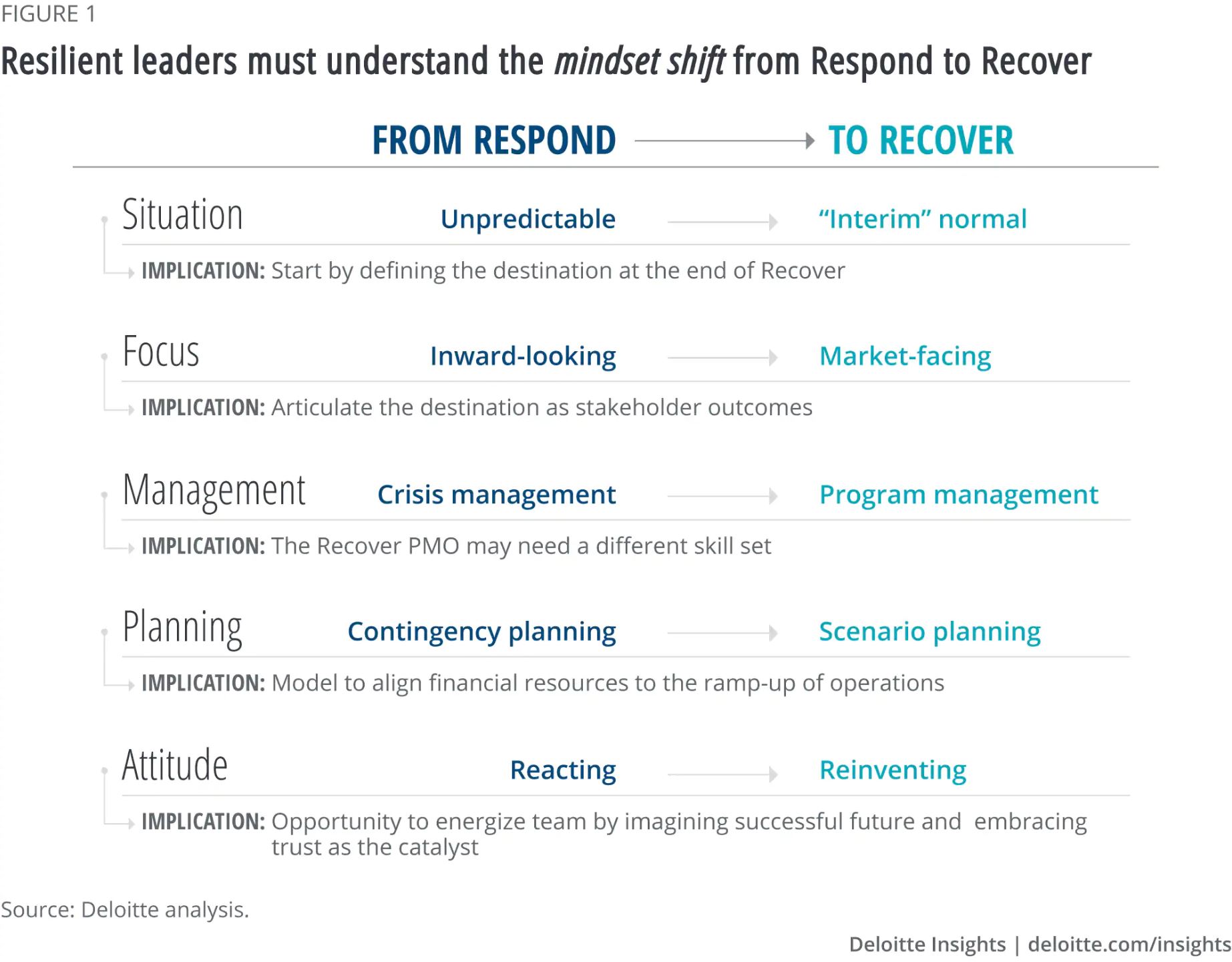
Meanwhile, McKinsey takes a look at what it means to cultivate compassionate leadership, breaking it down into four qualities: Awareness, vulnerability, empathy, and compassion.
Executive leadership consultancy Korn Ferry weighs in on the special blend of leadership skills they believe will be necessary for leaders to adopt during recovery:
- Leading with agility and humility
- Explicit and transparent leadership
- Keeping the business running effectively and securely
- ‘Out of the office but not out of work’ (which is a focus on managing remote work); and
- Engage, engage, engage
Bain and Co - in the same article as earlier - also has a neat model on maintaining a resilient mindset for a leader.
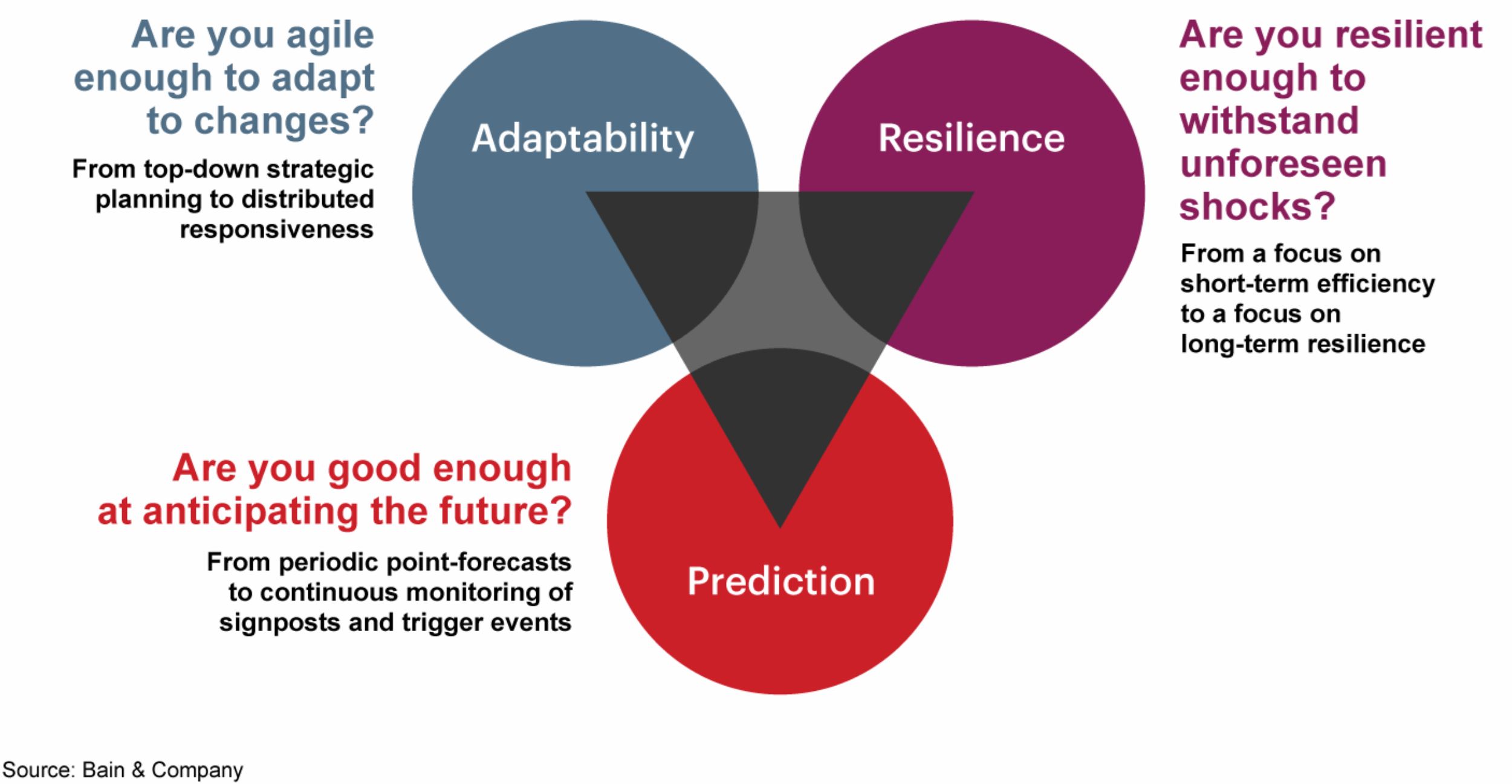
The Conversationencourages leaders to take care of their own self needs, specifically recommending leaders also be provided with emotional support, and to encourage role modeling (i.e. leading by example).
And finally, it is vital for a leader to continue to communicate. Boston Consulting Group believe that the most effective communication strategies will focus on:
- Purpose and its meaning in the post-crisis period
- Communication principles to inform the approach across all recovery phases
- Core creative platform from which all communication originates and is disseminated
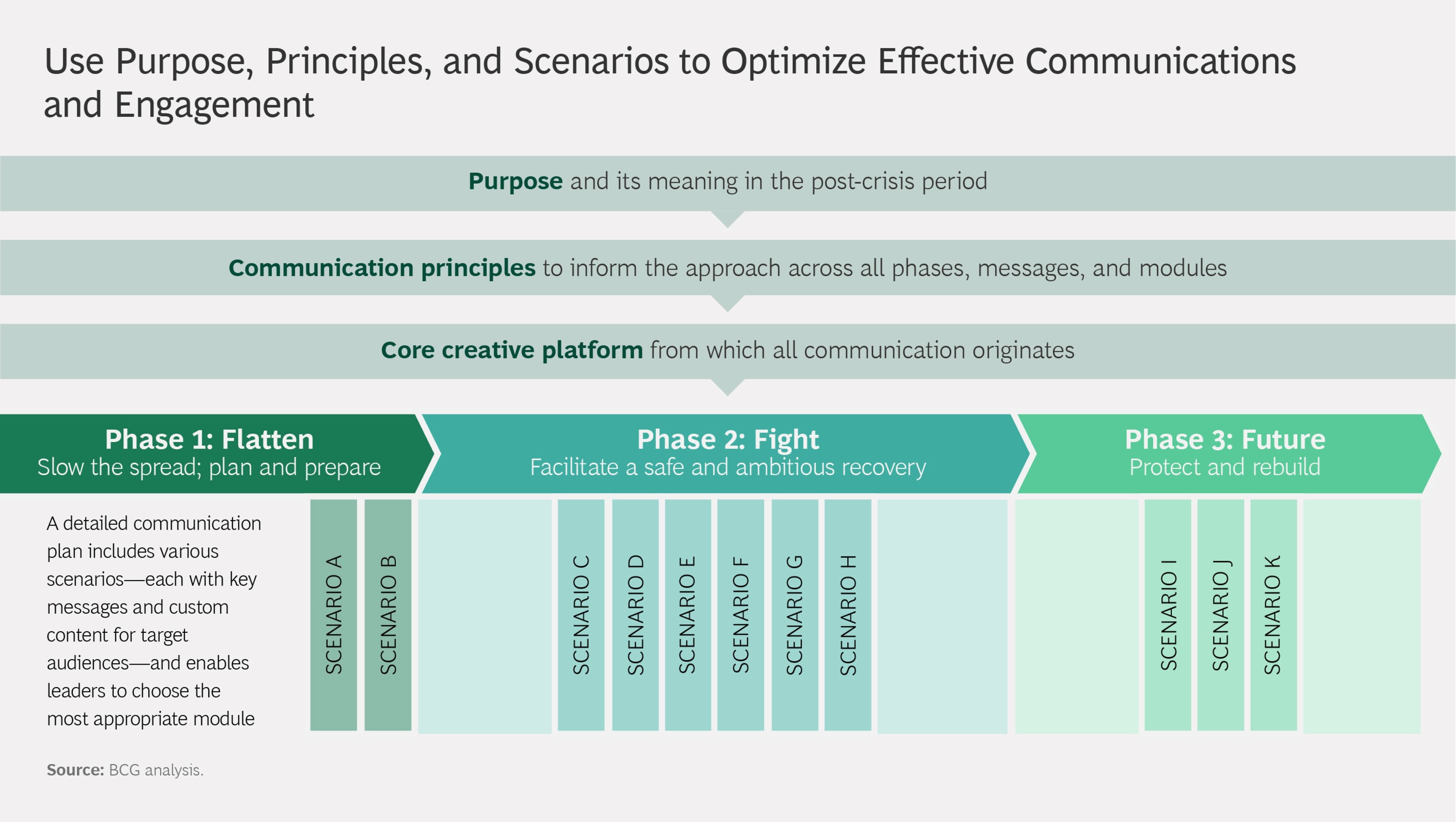
5. FOLLOWERSHIP AND TEAM WORK
And finally, this section focuses on the opposite but equally important side to leadership, that being followership. What can we do as team members to work with each other to support the overall organisation, especially during this period. This isn’t about blindly following instructions, but of taking individual leadership and responsibility, which includes standing up for doing the right thing. The aim is to create the optimal environment for recovery, whilst also allowing a leadership team to effectively lead.
Obligations and duties
Firstly, it’s important to understand that as an employee, you have an obligation under the OHS Act to cooperate with employers in implementing risk control measures.
You must take all reasonably practicable steps to ensure you don’t do anything that creates or increases a risk to the health and safety of yourself or others. In a pandemic situation, it is also reasonable to expect that your obligations will include complying with public health advice and any emergency measures.
For more information, please review the WorkSafe OHS guidelines to understand your legal duties.
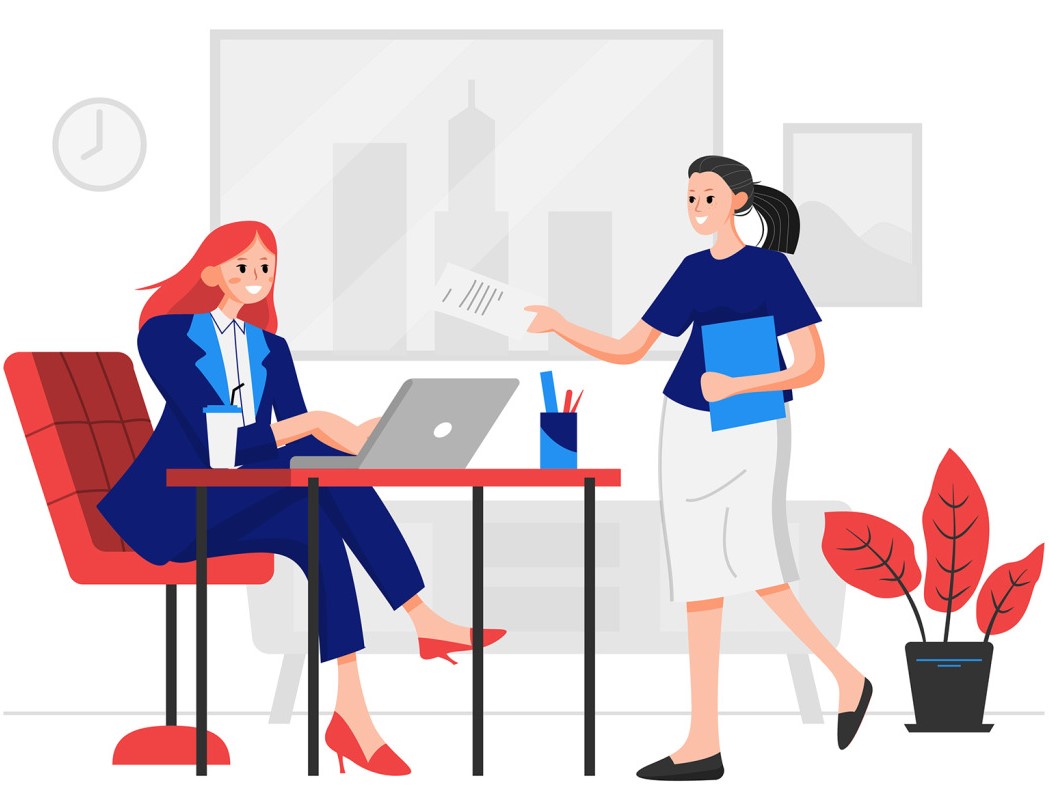
Being a good follower and team member
Unfortunately, there is not much written about what it means to be a good follower in the post-COVID-19 world. So what we’ve done here - much like with the previous segment on leadership - is provided links to a few insightful articles on what it means to be a good team player.
Business News Daily penned a piece on being an invaluable team player:
- Self-motivated, responsible, and proactive
- Courageous and willing to speak up when there are genuine problems to be addressed
- Is in service to others, and to the organisations you’re in
- Dedicated and committed, while maintaining judgment and honesty
- Hard-working, diligent, and collaborative, especially in a time when people may need to wear multiple hats
- Has good judgment, which is the line between following instructions whilst being mindful of what is being asked and maintaining ethical and moral standards. If you feel that you’re asked to undertake something unsafe, it’s ok to say no
- Being honest and able to demonstrate radical candour, providing leaders and colleagues with constructive feedback
Forbes has 15 tips from different business coaches on how to become a better team player, and workplace design consultant Anetta Pizag shares an employee-centric thought piece on ways we can make our own jobs more rewarding, productive, and fulfilling. She covers everything from personal time management, maintaining work life balance, overcoming challenges, approaching creative teamwork, and getting into the right headspace.
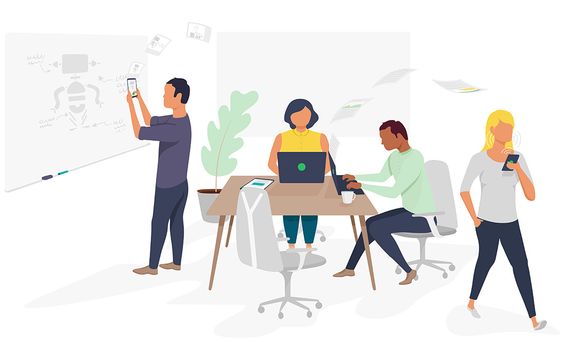
And whilst old, the Harvard Business Review has an in-depth article extolling the virtues of good followers and team players. The qualities they believe are important include:
- They manage themselves well.
- They are committed to the organization and to a purpose, principle, or person outside themselves.
- They build their competence and focus their efforts for maximum impact.
- They are courageous, honest, and credible.
Finally, if you are part of a team, it’s important to be respectful and empathetic of your other team members and leaders, especially as many will be in the same boat. This HBR article shares some insights on how you can empathise with others.
CONCLUSION
If you made it all the way through, thanks for checking out our guide. Some of you may be wondering what any of this has to do with ColourSpace and art, but the simple reason is that our broader purpose has always been about connecting people, and remembering our humanity throughout a challenging time. For us, art is but one way of keeping people connected. If you’d like to learn about how we can use art to bring your people together once the pandemic is over, please reach out here.
Otherwise, if you found this article useful, please pass it on. We want to help rebuild our community just as much as everyone else, and we hope this helped you out.
If you’d like to make a contribution to this article or want to get in touch, please email [email protected].






ColourSpace Gallery alert